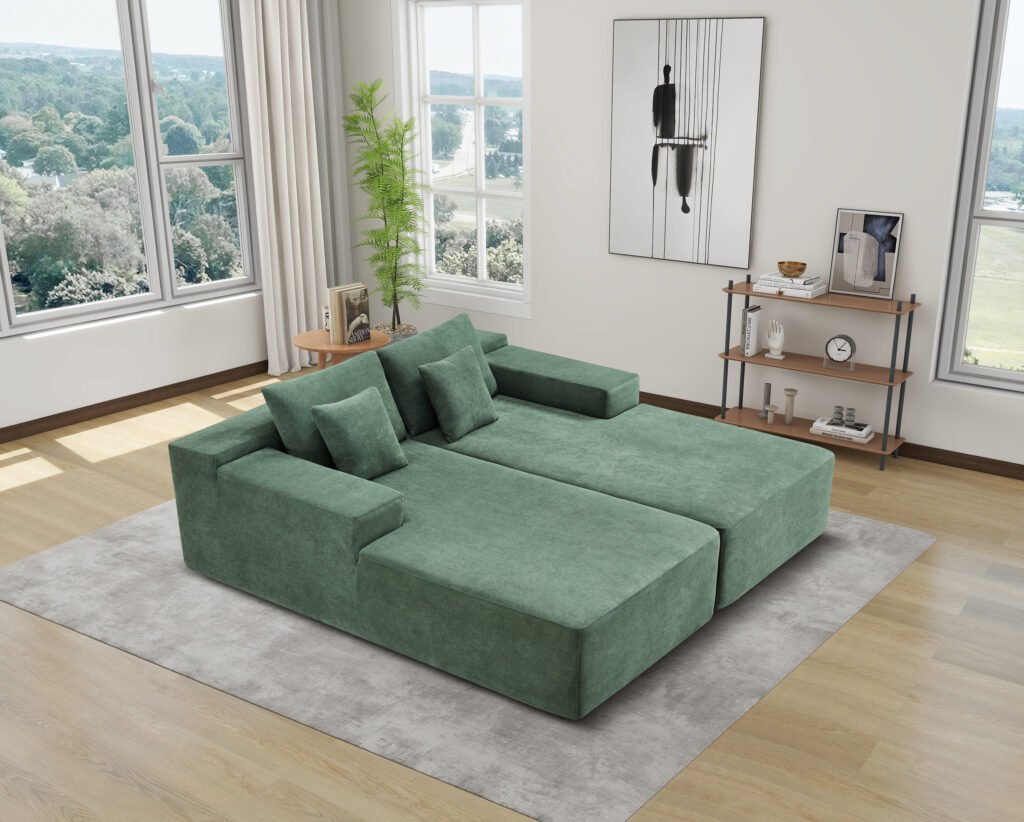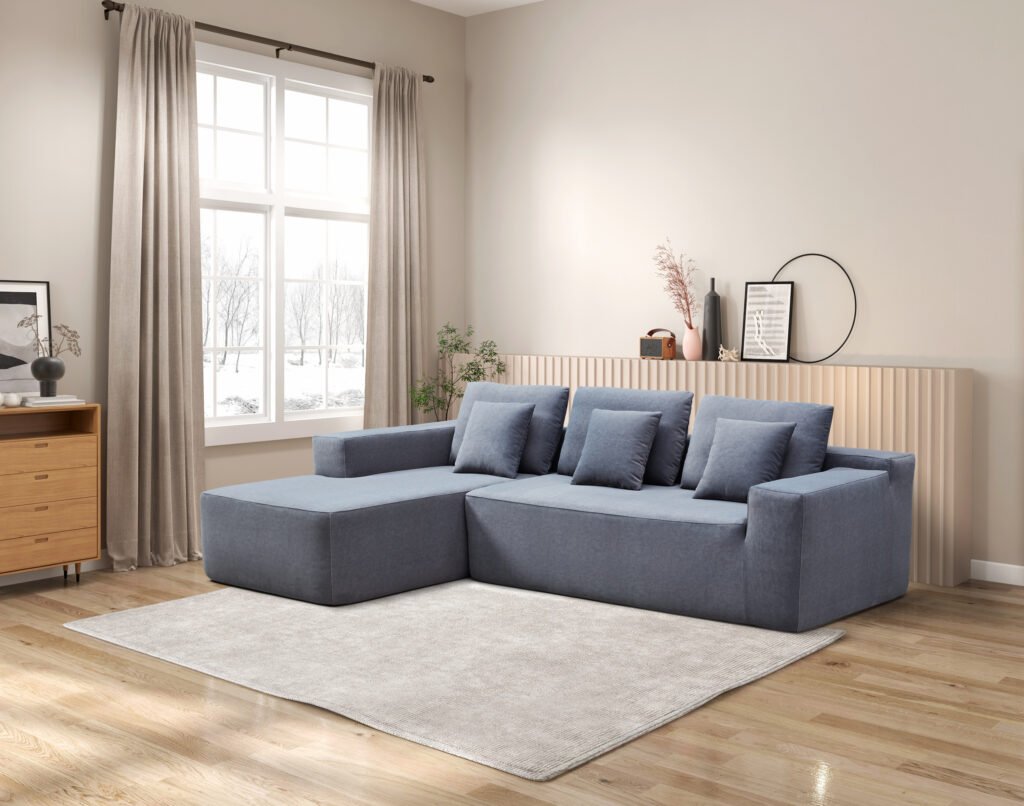With the increasing popularity of floor heating systems in modern homes, many homeowners and renters are considering how their furniture choices interact with these heating solutions. Compress sofas, known for their space-saving design and portability, are becoming a favored option for many living spaces, including those equipped with underfloor heating. However, questions arise about whether compress sofas are safe to use on floors with heating systems and how to optimize their placement to avoid damage to both the furniture and the heating system.
This comprehensive article explores the compatibility of compress sofas with floor heating systems, the risks involved, best practices for placement, and maintenance tips. We also include a detailed comparison table summarizing key considerations. Our company, Modular-Sofas.com, offers modular compress sofas designed with quality and durability in mind, suitable for modern homes with advanced heating solutions.


1. Understanding Floor Heating Systems and How They Work
Floor heating systems, also known as radiant floor heating, warm a room by heating the floor surface. The two main types are:
- Electric floor heating: Uses electric heating cables or mats installed beneath the floor surface.
- Hydronic (water-based) floor heating: Circulates warm water through pipes embedded in the floor.
These systems provide even heat distribution, improved energy efficiency, and enhanced comfort compared to traditional radiators.
The typical floor surface temperature ranges between 27°C to 29°C (80°F to 85°F), which is warm enough to heat the room without causing discomfort or damage under normal conditions.
2. Potential Concerns When Using Compress Sofas on Heated Floors
2.1 Heat Trapping and Its Effects
One of the primary concerns is heat trapping—when furniture placed directly on the floor blocks heat from dissipating evenly. This can lead to:
- Localized overheating under the furniture.
- Damage to floor coverings such as laminate, engineered wood, or carpets, including discoloration, cupping, or gapping.
- Reduced efficiency of the heating system due to inaccurate temperature sensor readings if sensors are located beneath or near the furniture.
- Potential safety risks or system failures in extreme cases.
Compress sofas, especially those with solid bases or low clearance, can trap heat if placed directly on heated floors without proper ventilation.
2.2 Material Sensitivity to Heat
Compress sofas typically use high rebound foam and durable fabrics. While these materials are generally heat-resistant within normal indoor temperature ranges, prolonged exposure to elevated temperatures caused by trapped heat may:
- Accelerate foam degradation.
- Cause fabric discoloration or weakening.
- Affect adhesives or modular connectors.
3. Best Practices for Using Compress Sofas with Floor Heating Systems
3.1 Maintain Adequate Clearance
Experts recommend maintaining a minimum clearance of 2-3 inches (5-7.5 cm) between the floor surface and the underside of furniture to allow free air circulation. This prevents heat from being trapped and ensures even heat distribution.
For compress sofas, this can be achieved by:
- Choosing models with legs or raised bases.
- Using furniture risers or pads to elevate the sofa slightly.
- Avoiding placing the sofa flush against the floor.
3.2 Avoid Blocking Heating Sensors
If the floor temperature sensor is located under or near the sofa, blocked airflow can cause false temperature readings. This may lead to the system reducing heat output prematurely, resulting in uneven room temperature.
Ensure that sensors remain exposed and unobstructed.


3.3 Use Protective Barriers
Consider placing heat-resistant furniture pads or breathable mats between the sofa and the floor. These allow heat to pass through while protecting the sofa’s base and the floor surface.
3.4 Regularly Move and Inspect the Sofa
Avoid leaving the compress sofa in the same spot for extended periods. Periodically moving the sofa allows heat to dissipate evenly and prevents localized overheating or discoloration.
Inspect both the floor and sofa base regularly for signs of heat damage or wear.
4. Material Considerations for Compress Sofas on Heated Floors
4.1 Foam Resilience
High rebound foam used in compress sofas is generally stable under normal floor heating temperatures. However, excessive heat from trapped areas can accelerate aging.
4.2 Fabric Durability
Choose compress sofas with fabrics that are:
- Heat-resistant and colorfast.
- Breathable to reduce moisture buildup.
- Easy to clean and maintain.
4.3 Modular Design Benefits
Modular compress sofas allow you to rearrange or remove sections to improve airflow and reduce heat trapping.
5. Comparison Table: Compress Sofas and Floor Heating Compatibility
| Factor | Considerations for Compress Sofas on Heated Floors | Recommendations |
|---|---|---|
| Clearance from Floor | Minimum 2-3 inches recommended to prevent heat trapping | Use sofa legs, risers, or pads |
| Heat Trapping Risk | High if sofa base is flat and flush with floor | Avoid solid bases; elevate sofa |
| Foam Material Heat Resistance | High rebound foam tolerates normal heating temperatures | Avoid prolonged exposure to trapped heat |
| Fabric Durability | Depends on fabric type; synthetic blends often more heat-resistant | Choose heat-resistant, breathable fabrics |
| Sensor Obstruction | Can cause false temperature readings and uneven heating | Keep sensors exposed |
| Floor Covering Impact | Heat trapped under sofa can discolor or warp flooring | Regularly move sofa; use protective pads |
| Modular Sofa Advantage | Allows rearrangement for better airflow and heat dissipation | Utilize modularity to optimize placement |
| Maintenance | Inspect for heat damage; clean regularly | Follow manufacturer care guidelines |
6. Insights from Industry Experts and Studies
According to WarmlyYours, a leading radiant heating manufacturer, furniture placed directly on heated floors can cause surface temperatures to rise significantly above ambient levels, leading to potential damage or system inefficiencies. They emphasize the importance of clearance and airflow to avoid trapped heat and recommend following flooring manufacturers’ humidity and heat guidelines to maintain floor integrity.
Similarly, JCW Underfloor Heating advises selecting furniture that allows heat flow, such as pieces with legs or castors, and avoiding heavy, solid furniture that blocks heat. Using specialized furniture pads designed for underfloor heating can further protect both the furniture and heating system.
7. Why Modular-Sofas.com Compress Sofas Are Suitable for Homes with Floor Heating
At Modular-Sofas.com, we design compress sofas with modern living environments in mind, including compatibility with floor heating systems. Our compress sofas feature:
- Elevated modular bases or legs to ensure airflow.
- High-quality, heat-resistant fabrics and foams.
- Modular components that can be rearranged to optimize heat circulation.
- Durable construction tested for long-term use in various home settings.
Our commitment to quality and sustainability means our sofas perform well without compromising your floor heating system’s efficiency or safety.


8. Practical Tips for Homeowners
- Measure clearance: Ensure your compress sofa has adequate space underneath.
- Use furniture risers: If your sofa sits too low, risers can elevate it safely.
- Avoid placing over sensors: Know your floor heating layout to avoid blocking sensors.
- Rotate furniture placement: Move sofas periodically to prevent heat buildup.
- Monitor flooring and sofa condition: Look for signs of discoloration, warping, or fabric damage.
- Consult professionals: For installation and placement advice tailored to your heating system.
9. Frequently Asked Questions
Q1: Can I place a compress sofa directly on a heated floor?
A1: It is generally not recommended to place compress sofas flush on heated floors without clearance, as this can trap heat and cause damage.
Q2: How much clearance is needed between the sofa and floor?
A2: A minimum of 2-3 inches is recommended to allow proper air circulation.
Q3: Will the foam in compress sofas be damaged by floor heating?
A3: High-quality high rebound foam used in compress sofas tolerates normal floor heating temperatures well if heat is not trapped.
Q4: Can modular compress sofas help with heat issues?
A4: Yes, modular designs allow rearrangement to improve airflow and reduce heat trapping.
Q5: Are there special pads for furniture on heated floors?
A5: Yes, heat-resistant and breathable furniture pads exist to protect floors and furniture.
10. Conclusion
Compress sofas can be safely used in homes with floor heating systems when proper precautions are taken. Ensuring adequate clearance, avoiding sensor obstruction, using heat-resistant materials, and leveraging modular designs are key to preventing heat trapping and maintaining both furniture and floor integrity.
Modular-Sofas.com offers compress sofas engineered to meet these requirements, combining comfort, durability, and compatibility with modern heating solutions. For homeowners seeking stylish, space-saving seating that works harmoniously with floor heating, our modular compress sofas are an excellent choice.
For more information and product details, visit Modular-Sofas.com.